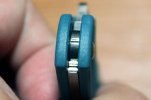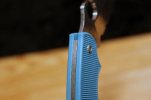Here's a brief and pic heavy overview of the Spyderco UK Penknife, leaf shape, full serrated version. The UKPK's, at least some versions, look to be discontinued by Spyderco, so you can find deals on them now.
Full disclosure: I'm selling these. But I picked them up to sell because I wanted one for myself. It's an unusual knife from Spyderco and at this price, heck, why not?
This knife fills a couple of holes in my collection. 1) It's my first blue knife. 2) It's my first serrated knife. I like plain edges best, so much so that every time I go to purchase a knife, I get the plain edge version. Which means my entire collection ended up being plain edged. 3) Super lightweight carry.
I carry a lot of slipjoints (might be about half of my collection), so I don't mind the non-locking part. I wasn't too sure what to expect from this one-hand opening slip joint, a lot rides on how heavy the spring is. The tension on the UKPK is just about right. You can even flick it open with a little help from your wrist.
To me, one of the coolest things about the UKPK is that it's made right here, in Colorado.

I've always wanted a knife that said made on "Earth".
When in your hand, you'll first notice the weight, or uhm, lack of weight. It's 1.9 ounces. 1.9 ounces with a near 3 inch blade. The handle is made of FRN and the texturing provides good grip. It feel like a medium-grippy G10.

The first thing you'll notice when you open it is the half-stop.

This half-stop acts as a safety feature, to prevent cutting your finger from an accidental closure. Unlike in a traditional slipjoint, where a half-stop is created with a flat surface in the tang, the half-stop in the UKPK is created with a notch.

A part of the backspring closes down into the notch on the tang. The tang is otherwise round except for the notch. This design element should be glossed over. With a traditional slipjoint, half-stops were often designed into a knife not for safety, but for ease of manufacturing. Creating a flat surface on the tang was easier than creating a completely round tang for smooth walk. In this case, with the UKPK, the tang is round but you still get a half-stop. The effect is a smooth walk with a slight hitch, instead of a full stop. And this design is what still allows the knife to be flicked open. You get the best of all worlds: good walk, half-stop for safety, and you can flick the blade open! BTW, talk is also excellent.
I spent a while trying to figure this out, and noticed another peculiarity of the knife. The back of the knife doesn't rock. It stays in place while the blade opens and closes. This looks to be very similar (if not exactly the same) design as Michael Vagnino's Zip Slip folders.



The working backspring is hidden underneath a the visible back of the knife. The working backspring does rock, but the spacer on the back of the knife hides the rocking.
Like other SpyderEdges, the secondary bevel is only on one side. Here is the back side:

The ergonomics are fantastic. The knife is very, very, very similar to the Caly3, which has excellent ergos. I just happen to have a Caly3 handy (thanks thaeffman!):

The only difference I could detect was on the choils. The choil on the UKPK is slightly, yet noticeably, more pronounced. The blade part of the choil extends further down than on the Caly3, so your index finger sits more snugly. The gimping on the UKPK is not quite as sharp as on the Caly3.
Closing the knife blade is easy to do one-handed. Just apply pressure to the ramp to release the slipjoint. There isn't much danger of cutting your fingers because the blade requires continuous pressure to close. You can't swing the blade closed. You have to push it all the way.
Two final points worth mentioning. 1) The UKPK wire clip sits very deep in the pocket. 2) You can "Spydie drop" the knife.
This is a very interesting knife. I'm going to be carrying it for a while to see if all Sal says about serrated edges outperforming plain edges is true.
Full disclosure: I'm selling these. But I picked them up to sell because I wanted one for myself. It's an unusual knife from Spyderco and at this price, heck, why not?
This knife fills a couple of holes in my collection. 1) It's my first blue knife. 2) It's my first serrated knife. I like plain edges best, so much so that every time I go to purchase a knife, I get the plain edge version. Which means my entire collection ended up being plain edged. 3) Super lightweight carry.
I carry a lot of slipjoints (might be about half of my collection), so I don't mind the non-locking part. I wasn't too sure what to expect from this one-hand opening slip joint, a lot rides on how heavy the spring is. The tension on the UKPK is just about right. You can even flick it open with a little help from your wrist.
To me, one of the coolest things about the UKPK is that it's made right here, in Colorado.

I've always wanted a knife that said made on "Earth".
When in your hand, you'll first notice the weight, or uhm, lack of weight. It's 1.9 ounces. 1.9 ounces with a near 3 inch blade. The handle is made of FRN and the texturing provides good grip. It feel like a medium-grippy G10.

The first thing you'll notice when you open it is the half-stop.

This half-stop acts as a safety feature, to prevent cutting your finger from an accidental closure. Unlike in a traditional slipjoint, where a half-stop is created with a flat surface in the tang, the half-stop in the UKPK is created with a notch.

A part of the backspring closes down into the notch on the tang. The tang is otherwise round except for the notch. This design element should be glossed over. With a traditional slipjoint, half-stops were often designed into a knife not for safety, but for ease of manufacturing. Creating a flat surface on the tang was easier than creating a completely round tang for smooth walk. In this case, with the UKPK, the tang is round but you still get a half-stop. The effect is a smooth walk with a slight hitch, instead of a full stop. And this design is what still allows the knife to be flicked open. You get the best of all worlds: good walk, half-stop for safety, and you can flick the blade open! BTW, talk is also excellent.
I spent a while trying to figure this out, and noticed another peculiarity of the knife. The back of the knife doesn't rock. It stays in place while the blade opens and closes. This looks to be very similar (if not exactly the same) design as Michael Vagnino's Zip Slip folders.



The working backspring is hidden underneath a the visible back of the knife. The working backspring does rock, but the spacer on the back of the knife hides the rocking.
Like other SpyderEdges, the secondary bevel is only on one side. Here is the back side:

The ergonomics are fantastic. The knife is very, very, very similar to the Caly3, which has excellent ergos. I just happen to have a Caly3 handy (thanks thaeffman!):

The only difference I could detect was on the choils. The choil on the UKPK is slightly, yet noticeably, more pronounced. The blade part of the choil extends further down than on the Caly3, so your index finger sits more snugly. The gimping on the UKPK is not quite as sharp as on the Caly3.
Closing the knife blade is easy to do one-handed. Just apply pressure to the ramp to release the slipjoint. There isn't much danger of cutting your fingers because the blade requires continuous pressure to close. You can't swing the blade closed. You have to push it all the way.
Two final points worth mentioning. 1) The UKPK wire clip sits very deep in the pocket. 2) You can "Spydie drop" the knife.
This is a very interesting knife. I'm going to be carrying it for a while to see if all Sal says about serrated edges outperforming plain edges is true.


